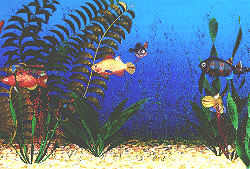One Fish,Two Fish
|
| COMPUTER-GENERATED FISH, spawned from algorithms built by the Russian company AnimaTek, are at the heart of a novel computer toy. Image courtesy of Maxis. |
How to raise a school of tempting software toys
Elizabeth Corcoran
These days Vladimir I. Pokhilko spends his time thinking about
fish. Not delicious morsels of shad and salmon - not even endangered creatures
such as short-nosed sturgeon. Instead Pokhilko is interested in virtual
ichthyology. "We have very, very beautiful fish," boasts the Russian, as
a few waft gracefully across his computer screen. And all are figments of
algorithmic manipulations.
Pokhilko is the U.S. representative for the Moscow-based start-up AnimaTek.
For the past three years, he and a team of 15 scraggly-haired scientists
and computer programmers have painstakingly toiled to fulfill a dream: write
software that electronically conceives images of glamorous fish. "They're
driven by a sense of aesthetics," observes Will Wright, chief designer at
the software toy company Maxis in Orinda, Calif. "They keep thinking about
how people will compete to breed beautiful fish."
That said, Maxis now hopes to help the Russians use their El-Fish to reel
in profits. As they see it, El-Fish will be a computer toy that people can
use to create novel-looking fish by electronically "breeding" images. Users
will endow the fish with characteristics that would enable them to survive
under specific environmental conditions. Unlike computer games aimed at squashing
aliens or conquering obstacles, El-Fish is a plaything for pacificists built
from surprisingly sophisticated algorithms.
Seven years ago neither Pokhilko nor any of his compatriots imagined themselves
as entrepreneurs. "El-Fish is a child of perestroika," Pokhilko declares.
Computers had permeated the premiere research institutions, and scientists
from many disciplines were tinkering with ways in which these tools might
advance their studies. As a psychologist, Pokhilko became intrigued with
using computers to model-and tease-human intelligence and so began devising
computer games.
In 1989, shortly after he had joined Moscow State University, Pokhilko met
hacker Alexey Pajitnov, the author of Tetris, the
first Russian computer game to slip across the border and become a commercial
hit in the West. They began tinkering with a number of computer projects,
including one that would automatically generate artificial lifeforms. Although
they were not familiar with U.S. work on genetic algorithms, developing software
that could selectively "breed," or recombine, images to generate new versions
seemed a promising approach [see "Genetic Algorithms"
by John H. Holland]. Although the Russians first thought about software that
would generate flowers, they settled on fish instead because the creatures
were mobile, pretty and popular pets. "So it was serious art and industry,"
Pokhilko says.
In the spring of 1989 the Russians found an enthusiastic backer in a small
U.S. firm, Bullet-Proof Software in Redmond, Wash. With funding from
Bullet-Proof, Pokhilko and Pajitnov bought computer hardware and software,
hired a team of scientists in Moscow (most of whom were theoretical and
experimental physicists) and plunged into the messy business of algorithmic
modeling. "It was a good time for private projects," Pokhilko recalls. "Some
people took the job just to survive."
Their first geometric models proved so flexible that the software churned
out many unusual images but no fish, Pokhilko sighs. By adding 800 parameters
-essentially a genetic code to describe generic fish bodies- the workers
finally ensured that their system would spew out only piscine figures.
Coaxing the fish to act like fish required more characteristics. The programmers
imbued the fish with sensitivity to water temperature and depth. (They also
designed lake environments and families of seaweed to provide a familiar
setting.) To enable the fish to swim, the scientists tuned the software to
sketch out 220 frames portraying fish in various angles and positions. Just
as cartoons spring to life when an artist quickly flips through many versions,
El-Fish meander across the screen when the computer runs through these frames
in different orders.
Lately El-Fish are surfacing at conferences ranging from scientific symposiums
on artificial life to trade shows on computer games. In demonstrations, Pokhilko
pulls up a menu of several dozen fish and picks two parents. In less than
30 seconds the first progeny pop onto the screen, soon followed by a school
of siblings. Pokhilko can then put the fish into a virtual lake stocked with
seaweed and other fish and monitor how the newest permutation survives.
Alternatively, he can save the fish image in a "museum" (which is environmentally
benign).
The software has gone through its own evolution since Pokhilko and Pajitov
brought it to the U.S. about a year ago. Even now the images consume much
computer memory: 10 fish swimming across a screen need about eight megabytes
of room, says Steve G. Beckert, a project manager at Maxis who is working
with the Russians. And then there are those extras, such as easy-to-use
interfaces, documentation and packaging- elements that are at the forefront
of any commercial vendor's agenda but are new to the entrepreneurs.
At this point, Maxis and AnimaTek hope to unveil a commercial El-Fish package
in time for Christmas. Precisely how the final product will fare is as uncertain
as the outcome of breeding fish. Nevertheless, as Pokhilko points out, "sometimes
a little bit of mutation is absolutely necessary to generate a beautiful
fish."
